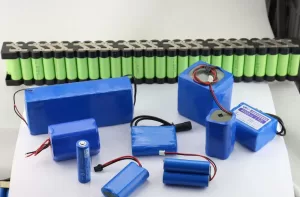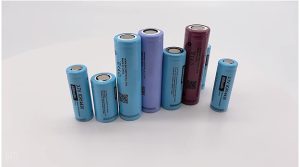What is the relationship between lithium-ion battery voltage and 18650 battery capacity?
18650 is the originator of the lithium-ion battery – a standard model of the lithium-ion battery set by the company SONY to save costs. 18 means a diameter of 18 mm, 65 means a length of 65 mm, and 0 means a cylindrical battery.
The common 18650 battery is divided into a lithium-ion battery and a lithium-iron-phosphate battery. The voltage of the lithium-ion battery is 3.7 V, the end-of-charge voltage is 4.2 V, the lithium-iron-phosphate battery has a nominal voltage of 3.2 V, the end-of-charge voltage is 3.6 V, the capacity is usually 1200 mAh-3350 mAh, and the usual capacity is 2200 mAh-2600 mAh.
18650 Li-Ion battery applications
The theory of 18650 battery life is that they can be charged 1000 times cyclically. Due to the large capacity per unit density, most of them are used in laptop batteries. In addition, the stability of 18650 is very good at work. It is widely used in various electronic fields: It is widely used in high-quality flash lamps. power, wireless data transmitters, electric warm clothing and footwear, portable meters, portable lighting equipment, portable printers, industrial equipment, medical equipment, etc.
The relationship between lithium battery voltage and power
To analyze the correspondence between the open-circuit voltage of the lithium-ion battery and the battery capacity, first, enter a table: as follows, the percentage is the remaining capacity of the battery, and the right side is the open-circuit voltage (OCV) of the corresponding battery.
100%—-4.20V
90%—–4.06V
80%—–3.98V
70%—–3.92V
60%—–3.87V
50%—–3.82V
40%—–3.79V
30%—–3.77V
20%—–3.74V
10%—–3.68V
5%——3.45V
0%——3.00V
However, lithium-ion batteries have a property that is useful for current measurement. When discharging, the battery voltage gradually decreases with the current flow and shows a considerable slope. This provides us with another approximate method of measuring current. Measuring battery voltage is similar to measuring the water level in a water tank to estimate the amount of water remaining. But in reality, battery voltage is much more complicated than quietly measuring the water level in the tank.
Using the voltage to estimate the remaining capacity of the battery is associated with the following instabilities:
1. For the same battery, with the same remaining capacity, the voltage value changes by the amount of discharge current. The higher the discharge current, the lower the voltage. When there is no current, the voltage is the highest.
2. The influence of the ambient temperature on the battery voltage. The lower the temperature, the lower the battery voltage for the same capacity.
3. The effect of the cycle on the battery discharge platform. As the cycle progresses, the discharge platform of the lithium-ion battery tends to deteriorate. The discharge platform is lowered. Therefore, the capacity at the same voltage will also change accordingly.
4. With Different manufacturers, and different capacity lithium-ion batteries, the discharge platform is slightly different.
5. Lithium-ion batteries with different electrode materials have large differences in discharge platform. The discharge platforms of cobalt lithium and manganese lithium are completely different.









Leave a reply